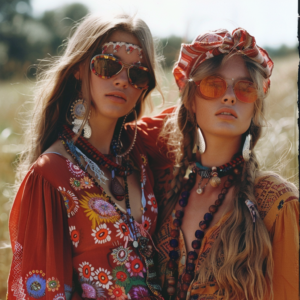Introduction
Fashion has always been a reflection of society, its values, norms, and gender roles. It has the power to both restrict and liberate individuals, influencing their behavior, movements, and self-expression. Women’s fashion, in particular, has undergone significant transformations throughout history, acting as a barometer for the changing roles of women in society. This article takes a closer look at the journey of women’s fashion, from the restrictive petticoats of the past to the empowering pants of today.
The Era of Petticoats: 18th and 19th Centuries
Imagine walking downstairs in a floor-length ball gown, complete with layers of petticoats, to enjoy a cup of tea. For women in the 18th and 19th centuries, this was a daily reality. Petticoats, often made of linen, cotton, or silk, were worn under large skirts to provide volume and warmth. These underskirts, which could range from one to seven in number, were heavily embellished and served as a symbol of affluence and status.
However, the grandeur of petticoats came with limitations. The layers of fabric not only restricted mobility but also hindered women’s participation in various activities. Petticoats, in essence, were a physical representation of the societal expectations placed upon women during this period – to be graceful, gentle, and primarily focused on domestic duties.
A Revolution in Women’s Fashion: The Early 20th Century
As the world moved into the 20th century, profound changes in women’s roles and rights began to take shape. With the onset of the World Wars, women found themselves filling traditionally male jobs, leading to a shift in societal norms. This transformation was reflected in their fashion as well.
In response to the practical needs of the workforce, women began adopting trousers and pantsuits. This trend was initially met with apprehension and scandal, as it challenged the long-established gender norms. However, pants gradually became an emblem for the increasingly prominent role of women in society. By the mid-20th century, it was evident that trousers were here to stay, symbolizing women’s rebellion against the stereotype and embracing a newfound sense of strength and freedom.
The Modern Age: Beyond Silhouettes
In today’s world, fashion has transcended beyond silhouettes to become a form of self-expression, individuality, and comfort. Women are no longer bound by the dictations of societal expectations, but instead, they are choosing what to wear based on their personal preferences. From athleisure wear to androgynous fashion, the lines between men’s and women’s clothing have become increasingly blurred.
Fashion designers and brands alike are recognizing the importance of inclusivity and diversity, offering a broader range of sizes, styles, and cultural influences to cater to the unique needs and desires of women. This shift has enabled women to confidently express their identity through fashion, unencumbered by societal pressures or stereotypes.
The Future of Women’s Fashion: Embracing Change
As our society continues to evolve, so too will fashion and the role of women in it. With the rise of gender-neutral clothing, we may see further blending of men’s and women’s fashion, resulting in a more unified and egalitarian approach to style. As consumers become more socially and environmentally conscious, the demand for sustainable and ethical fashion practices will continue to grow, transforming the industry from within.
Conclusion
The transformation of women’s fashion throughout history has been a reflection of the changing societal roles and expectations placed upon women. From the restrictive petticoats of the 18th and 19th centuries to the empowering pants of the modern age, fashion has been an agent of change and a platform for self-expression. As we look to the future, it is exciting to imagine how fashion will continue to mirror and influence the evolving roles of women within our society.
